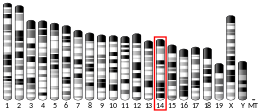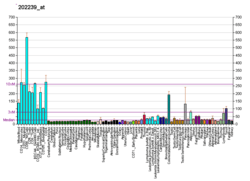PARP4
Poly [ADP-ribose] polymerase 4 is an enzyme that in humans is encoded by the PARP4 gene.[5][6]
This gene encodes poly(ADP-ribosyl)transferase-like 1 protein, which is capable of catalyzing a poly(ADP-ribosyl)ation reaction. This protein has a catalytic domain which is homologous to that of poly (ADP-ribosyl) transferase, but lacks an N-terminal DNA binding domain which activates the C-terminal catalytic domain of poly (ADP-ribosyl) transferase. Since this protein is not capable of binding DNA directly, its transferase activity may be activated by other factors such as protein-protein interaction mediated by the extensive carboxyl terminus.[6]
Interactions
PARP4 has been shown to interact with Major vault protein.[7][8]
gollark: I don't think they ever had an actual collective consciousness like that, no.
gollark: It has at no points contained a collective consciousness which never had internal disagreement. Probably.
gollark: YET.
gollark: Germany is not really a single unified entity.
gollark: Yes, I agree, America has unreasonably vast military spending/
References
- GRCh38: Ensembl release 89: ENSG00000102699 - Ensembl, May 2017
- GRCm38: Ensembl release 89: ENSMUSG00000054509 - Ensembl, May 2017
- "Human PubMed Reference:". National Center for Biotechnology Information, U.S. National Library of Medicine.
- "Mouse PubMed Reference:". National Center for Biotechnology Information, U.S. National Library of Medicine.
- Still IH, Vince P, Cowell JK (Mar 2000). "Identification of a novel gene (ADPRTL1) encoding a potential Poly(ADP-ribosyl)transferase protein". Genomics. 62 (3): 533–6. doi:10.1006/geno.1999.6024. PMID 10644454.
- "Entrez Gene: PARP4 poly (ADP-ribose) polymerase family, member 4".
- van Zon, Arend; Mossink Marieke H; Schoester Martijn; Scheffer George L; Scheper Rik J; Sonneveld Pieter; Wiemer Erik A C (Mar 2002). "Structural domains of vault proteins: a role for the coiled coil domain in vault assembly". Biochem. Biophys. Res. Commun. 291 (3): 535–41. doi:10.1006/bbrc.2002.6472. ISSN 0006-291X. PMID 11855821.
- Kickhoefer, V A; Siva A C; Kedersha N L; Inman E M; Ruland C; Streuli M; Rome L H (Sep 1999). "The 193-kD vault protein, VPARP, is a novel poly(ADP-ribose) polymerase". J. Cell Biol. 146 (5): 917–28. doi:10.1083/jcb.146.5.917. ISSN 0021-9525. PMC 2169495. PMID 10477748.
Further reading
- Jean L, Risler JL, Nagase T, et al. (1999). "The nuclear protein PH5P of the inter-alpha-inhibitor superfamily: a missing link between poly(ADP-ribose)polymerase and the inter-alpha-inhibitor family and a novel actor of DNA repair?". FEBS Lett. 446 (1): 6–8. doi:10.1016/S0014-5793(99)00173-8. PMID 10100603.
- Soldani C, Scovassi AI (2003). "Poly(ADP-ribose) polymerase-1 cleavage during apoptosis: an update". Apoptosis. 7 (4): 321–8. doi:10.1023/A:1016119328968. PMID 12101391.
- Bouchard VJ, Rouleau M, Poirier GG (2003). "PARP-1, a determinant of cell survival in response to DNA damage". Exp. Hematol. 31 (6): 446–54. doi:10.1016/S0301-472X(03)00083-3. PMID 12829019.
- Soares MB, Bonaldo MF, Jelene P, et al. (1994). "Construction and characterization of a normalized cDNA library". Proc. Natl. Acad. Sci. U.S.A. 91 (20): 9228–32. Bibcode:1994PNAS...91.9228S. doi:10.1073/pnas.91.20.9228. PMC 44785. PMID 7937745.
- Nagase T, Seki N, Ishikawa K, et al. (1996). "Prediction of the coding sequences of unidentified human genes. V. The coding sequences of 40 new genes (KIAA0161-KIAA0200) deduced by analysis of cDNA clones from human cell line KG-1". DNA Res. 3 (1): 17–24. doi:10.1093/dnares/3.1.17. PMID 8724849.
- Kickhoefer VA, Siva AC, Kedersha NL, et al. (1999). "The 193-kD vault protein, VPARP, is a novel poly(ADP-ribose) polymerase". J. Cell Biol. 146 (5): 917–28. doi:10.1083/jcb.146.5.917. PMC 2169495. PMID 10477748.
- Kickhoefer VA, Stephen AG, Harrington L, et al. (2000). "Vaults and telomerase share a common subunit, TEP1". J. Biol. Chem. 274 (46): 32712–7. doi:10.1074/jbc.274.46.32712. PMID 10551828.
- Siva AC, Raval-Fernandes S, Stephen AG, et al. (2001). "Up-regulation of vaults may be necessary but not sufficient for multidrug resistance". Int. J. Cancer. 92 (2): 195–202. doi:10.1002/1097-0215(200102)9999:9999<::AID-IJC1168>3.0.CO;2-7. PMID 11291045.
- van Zon A, Mossink MH, Schoester M, et al. (2001). "Multiple human vault RNAs. Expression and association with the vault complex". J. Biol. Chem. 276 (40): 37715–21. doi:10.1074/jbc.M106055200. PMID 11479319.
- van Zon A, Mossink MH, Schoester M, et al. (2002). "Structural domains of vault proteins: a role for the coiled coil domain in vault assembly". Biochem. Biophys. Res. Commun. 291 (3): 535–41. doi:10.1006/bbrc.2002.6472. PMID 11855821.
- Mazzon E, Dugo L, Li JH, et al. (2002). "GPI 6150, a PARP inhibitor, reduces the colon injury caused by dinitrobenzene sulfonic acid in the rat". Biochem. Pharmacol. 64 (2): 327–37. doi:10.1016/S0006-2952(02)01075-4. PMID 12123754.
- Liu TJ, Lin SY, Chau YP (2002). "Inhibition of poly(ADP-ribose) polymerase activation attenuates beta-lapachone-induced necrotic cell death in human osteosarcoma cells". Toxicol. Appl. Pharmacol. 182 (2): 116–25. doi:10.1006/taap.2002.9438. PMID 12140175.
- Nie Z, Phenix BN, Lum JJ, et al. (2003). "HIV-1 protease processes procaspase 8 to cause mitochondrial release of cytochrome c, caspase cleavage and nuclear fragmentation". Cell Death Differ. 9 (11): 1172–84. doi:10.1038/sj.cdd.4401094. PMID 12404116.
- Strausberg RL, Feingold EA, Grouse LH, et al. (2003). "Generation and initial analysis of more than 15,000 full-length human and mouse cDNA sequences". Proc. Natl. Acad. Sci. U.S.A. 99 (26): 16899–903. Bibcode:2002PNAS...9916899M. doi:10.1073/pnas.242603899. PMC 139241. PMID 12477932.
- Dunham A, Matthews LH, Burton J, et al. (2004). "The DNA sequence and analysis of human chromosome 13". Nature. 428 (6982): 522–8. Bibcode:2004Natur.428..522D. doi:10.1038/nature02379. PMC 2665288. PMID 15057823.
- Liu Y, Snow BE, Kickhoefer VA, et al. (2004). "Vault poly(ADP-ribose) polymerase is associated with mammalian telomerase and is dispensable for telomerase function and vault structure in vivo". Mol. Cell. Biol. 24 (12): 5314–23. doi:10.1128/MCB.24.12.5314-5323.2004. PMC 419898. PMID 15169895.
This article is issued from Wikipedia. The text is licensed under Creative Commons - Attribution - Sharealike. Additional terms may apply for the media files.




